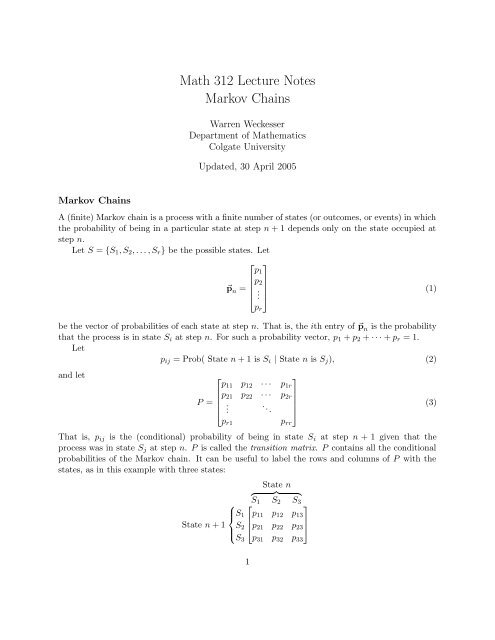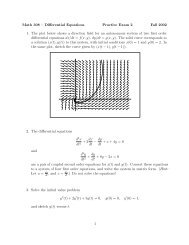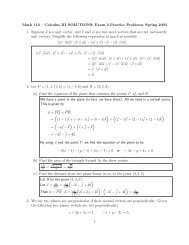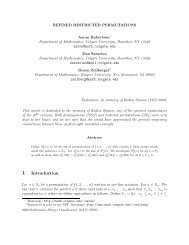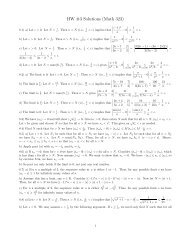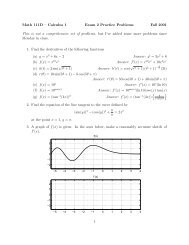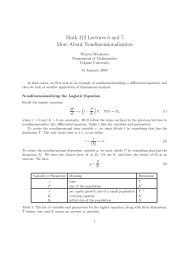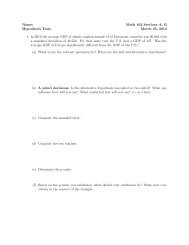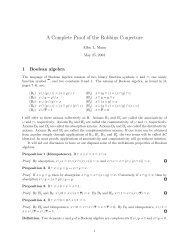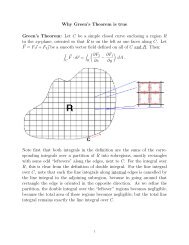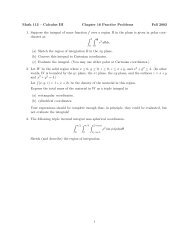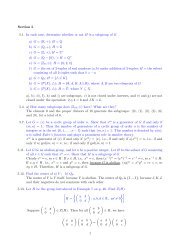Math 312 Lecture Notes Markov Chains - Department of Mathematics
Math 312 Lecture Notes Markov Chains - Department of Mathematics
Math 312 Lecture Notes Markov Chains - Department of Mathematics
You also want an ePaper? Increase the reach of your titles
YUMPU automatically turns print PDFs into web optimized ePapers that Google loves.
<strong>Math</strong> <strong>312</strong> <strong>Lecture</strong> <strong>Notes</strong><br />
<strong>Markov</strong> <strong>Chains</strong><br />
Warren Weckesser<br />
<strong>Department</strong> <strong>of</strong> <strong>Math</strong>ematics<br />
Colgate University<br />
Updated, 30 April 2005<br />
<strong>Markov</strong> <strong>Chains</strong><br />
A (finite) <strong>Markov</strong> chain is a process with a finite number <strong>of</strong> states (or outcomes, or events) in which<br />
the probability <strong>of</strong> being in a particular state at step n + 1 depends only on the state occupied at<br />
step n.<br />
Let S = {S 1 , S 2 , . . . , S r } be the possible states. Let<br />
⎡ ⎤<br />
p 1<br />
p 2<br />
⃗p n = ⎢ ⎥<br />
(1)<br />
⎣ . ⎦<br />
p r<br />
be the vector <strong>of</strong> probabilities <strong>of</strong> each state at step n. That is, the ith entry <strong>of</strong> ⃗p n is the probability<br />
that the process is in state S i at step n. For such a probability vector, p 1 + p 2 + · · · + p r = 1.<br />
Let<br />
p ij = Prob( State n + 1 is S i | State n is S j ), (2)<br />
and let<br />
⎡<br />
⎤<br />
p 11 p 12 · · · p 1r<br />
p 21 p 22 · · · p 2r<br />
P = ⎢<br />
⎣<br />
.<br />
. ..<br />
⎥<br />
⎦<br />
p rr<br />
p r1<br />
That is, p ij is the (conditional) probability <strong>of</strong> being in state S i at step n + 1 given that the<br />
process was in state S j at step n. P is called the transition matrix. P contains all the conditional<br />
probabilities <strong>of</strong> the <strong>Markov</strong> chain. It can be useful to label the rows and columns <strong>of</strong> P with the<br />
states, as in this example with three states:<br />
State n<br />
{ }} {<br />
⎧<br />
S 1 S 2 S<br />
⎡<br />
3<br />
⎤<br />
⎪⎨ S 1 p 11 p 12 p 13<br />
⎢<br />
⎥<br />
State n + 1 S 2 ⎣p 21 p 22 p 23 ⎦<br />
⎪⎩<br />
S 3 p 31 p 32 p 33<br />
1<br />
(3)
The fundamental property <strong>of</strong> a <strong>Markov</strong> chain is that<br />
⃗p n+1 = P ⃗p n . (4)<br />
Given an initial probability vector ⃗p 0 , we can determine the probability vector at any step n by<br />
computing the iterates <strong>of</strong> a linear map.<br />
The information contained in the transition matrix can also be represented in a transition<br />
diagram. In a transition diagram, the states are arranged in a diagram, typically with a “bubble”<br />
around each state. If p ij > 0, then an arrow is drawn from state j to state i, and the arrow is<br />
labeled with p ij . Examples are given in the following discussions.<br />
In these notes, we will consider two special cases <strong>of</strong> <strong>Markov</strong> chains: regular <strong>Markov</strong> chains and<br />
absorbing <strong>Markov</strong> chains. Generalizations <strong>of</strong> <strong>Markov</strong> chains, including continuous time <strong>Markov</strong><br />
processes and infinite dimensional <strong>Markov</strong> processes, are widely studied, but we will not discuss<br />
them in these notes.<br />
Regular <strong>Markov</strong> <strong>Chains</strong><br />
Definition. A <strong>Markov</strong> chain is a regular <strong>Markov</strong> chain if some power <strong>of</strong> the transition matrix has<br />
only positive entries. That is, if we define the (i, j) entry <strong>of</strong> P n to be p (n)<br />
ij<br />
, then the <strong>Markov</strong> chain<br />
is regular if there is some n such that p (n)<br />
ij<br />
> 0 for all (i, j).<br />
If a <strong>Markov</strong> chain is regular, then no matter what the initial state, in n steps there is a positive<br />
probability that the process is in any <strong>of</strong> the states.<br />
Essential facts about regular <strong>Markov</strong> chains.<br />
1. P n → W as n → ∞, where W is a constant matrix and all the columns <strong>of</strong> W are the same.<br />
2. There is a unique probability vector ⃗w such that P ⃗w = ⃗w.<br />
Note:<br />
(a) ⃗w is a fixed point <strong>of</strong> the linear map ⃗x i+1 = P⃗x i .<br />
(b) ⃗w is an eigenvector associated with the eigenvalue λ = 1. (The claim implies that the<br />
transition matrix P <strong>of</strong> a regular <strong>Markov</strong> chain must have the eigenvalue λ = 1. Then ⃗w<br />
is the eigenvector whose entries add up to 1.)<br />
(c) The matrix W is W = [ ⃗w ⃗w · · · ⃗w ] .<br />
3. P n ⃗p 0 → ⃗w as n → ∞ for any initial probability vector ⃗p 0 . Thus ⃗w gives the long-term<br />
probability distribution <strong>of</strong> the states <strong>of</strong> the <strong>Markov</strong> chain.<br />
Example: Sunny or Cloudy. A meteorologist studying the weather in a region decides to<br />
classify each day as simply sunny or cloudy. After analyzing several years <strong>of</strong> weather records, he<br />
finds:<br />
• the day after a sunny day is sunny 80% <strong>of</strong> the time, and cloudy 20% <strong>of</strong> the time; and<br />
• the day after a cloudy day is sunny 60% <strong>of</strong> the time, and cloudy 40% <strong>of</strong> the time.<br />
2
We can setup up a <strong>Markov</strong> chain to model this process. There are just two states: S 1 = sunny,<br />
and S 2 = cloudy. The transition diagram is<br />
and the transition matrix is<br />
0.8 0.2<br />
State 1<br />
Sunny<br />
P =<br />
0.6<br />
State 2<br />
Cloudy<br />
0.4<br />
[ ] 0.8 0.6<br />
. (5)<br />
0.2 0.4<br />
We see that all entries <strong>of</strong> P are positive, so the <strong>Markov</strong> chain is regular. (The conditions <strong>of</strong> the<br />
definition are satisfied when n = 1.)<br />
To find the long-term probabilities <strong>of</strong> sunny and cloudy days, we must find the eigenvector <strong>of</strong><br />
P associated with the eigenvalue λ = 1. We know from Linear Algebra that if ⃗v is an eigenvector,<br />
then so is c⃗v for any constant c ≠ 0. The probability vector ⃗w is the eigenvector that is also a<br />
probability vector. That is, the sum <strong>of</strong> the entries <strong>of</strong> the vector ⃗w must be 1.<br />
We solve<br />
P ⃗w = ⃗w<br />
(P − I)⃗w = ⃗0<br />
(6)<br />
Now<br />
P − I =<br />
[ −0.2<br />
] 0.6<br />
0.2 −0.6<br />
If you have recently studied Linear Algebra, you could probably write the answer down with no<br />
further work, but we will show the details here. We form the augmented matrix and use Gaussian<br />
elimination:<br />
⎡<br />
⎤ ⎡<br />
⎤<br />
⎣<br />
−0.2 0.6 . 0<br />
⎦ → ⎣ 1 −3 . 0 ⎦ (8)<br />
0.2 −0.6 . 0 0 0 . 0<br />
which tells us w 1 = 3w 2 , or w 1 = 3s, w 2 = s, where s is arbitrary, or<br />
[ 3<br />
⃗w = s<br />
1]<br />
(7)<br />
(9)<br />
The vector ⃗w must be a probability vector, so w 1 + w 2 = 1. This implies 4s = 1 or s = 1/4. Thus<br />
[ ] 3/4<br />
⃗w = . (10)<br />
1/4<br />
This vector tells us that in the long run, the probability is 3/4 that the process will be in state 1,<br />
and 1/4 that the process will be in state 2. In other words, in the long run 75% <strong>of</strong> the days are<br />
sunny and 25% <strong>of</strong> the days are cloudy.<br />
3
Examples: Regular or not<br />
chain is regular.<br />
Here are a few examples <strong>of</strong> determining whether or not a <strong>Markov</strong><br />
1. Suppose the transition matrix is<br />
We find<br />
and, in general,<br />
P =<br />
[ ] 1/3 0<br />
. (11)<br />
2/3 1<br />
[<br />
P 2 (1/3)<br />
=<br />
2 ] [<br />
0<br />
, P 3 (1/3)<br />
=<br />
3 ]<br />
0<br />
(2/3)(1 + 1/3) 1<br />
(2/3)(1 + 1/3 + (1/3) 2 , (12)<br />
) 1<br />
[<br />
P n (1/3)<br />
=<br />
n ]<br />
0<br />
(2/3)(1 + 1/3 + · · · + (1/3) n−1 . (13)<br />
) 1<br />
The upper right entry in P n is 0 for all n, so the <strong>Markov</strong> chain is not regular.<br />
2. Here’s a simple example that is not regular.<br />
P =<br />
[ ] 0 1<br />
1 0<br />
(14)<br />
Then<br />
P 2 = I, P 3 = P, etc. (15)<br />
Since P n = I if n is even and P n = P if n is odd, P always has two entries that are zero.<br />
Therefore the <strong>Markov</strong> chain is not regular.<br />
3. Let<br />
⎡<br />
1/5 1/5<br />
⎤<br />
2/5<br />
P = ⎣ 0 2/5 3/5⎦ (16)<br />
4/5 2/5 0<br />
The transition matrix has two entries that are zero, but<br />
⎡<br />
9/25 7/25<br />
⎤<br />
5/25<br />
P 2 = ⎣12/25 10/25 6/25 ⎦ . (17)<br />
4/25 8/25 14/25<br />
Since all the entries <strong>of</strong> P 2 are positive, the <strong>Markov</strong> chain is regular.<br />
4
Absorbing <strong>Markov</strong> <strong>Chains</strong><br />
We consider another important class <strong>of</strong> <strong>Markov</strong> chains. A state S k <strong>of</strong> a <strong>Markov</strong> chain is called<br />
an absorbing state if, once the <strong>Markov</strong> chains enters the state, it remains there forever. In other<br />
words, the probability <strong>of</strong> leaving the state is zero. This means p kk = 1, and p jk = 0 for j ≠ k.<br />
A <strong>Markov</strong> chain is called an absorbing chain if<br />
(i) it has at least one absorbing state; and<br />
(ii) for every state in the chain, the probability <strong>of</strong> reaching an absorbing state in a finite number<br />
<strong>of</strong> steps is nonzero.<br />
An essential observation for an absorbing <strong>Markov</strong> chain is that it will eventually enter an absorbing<br />
state. (This is a consequence <strong>of</strong> the fact that if a random event has a probability p > 0 <strong>of</strong> occurring,<br />
then the probability that it does not occur is 1 − p, and the probability that it does not occur in<br />
n trials is (1 − p) n . As n → ∞, the probability that the event does not occur goes to zero.) The<br />
non-absorbing states in an absorbing <strong>Markov</strong> chain are called transient states.<br />
Suppose an absorbing <strong>Markov</strong> chain has k absorbing states and l transient states. If, in our set<br />
<strong>of</strong> states, we list the absorbing states first, we see that the transition matrix has the form<br />
That is, we may partition P as<br />
Absorbing States Transient States<br />
{ }} { { }} {<br />
S 1 S 2 · · · S k S k+1 · · · S<br />
⎡<br />
k+l<br />
⎤<br />
S 1 1 0 · · · 0 p 1,k+1 · · · p 1,k+l<br />
S 2<br />
0 1 . .<br />
.<br />
.<br />
. . .. 0<br />
S k<br />
0 · · · 0 1 p k,k+1 · · · p k,k+l<br />
S k+1<br />
0 · · · · · · 0 p k+1,k+1 · · · p k+1,k+l<br />
⎢<br />
⎥<br />
. ⎣.<br />
. .<br />
. ⎦<br />
S k+l 0 · · · · · · 0 p k+l,k+1 · · · p k+l,k+l<br />
P =<br />
[ ] I R<br />
0 Q<br />
where I is k × k, R is k × l, 0 is l × k and Q is l × l. R gives the probabilities <strong>of</strong> transitions from<br />
transient states to absorbing states, while Q gives the probabilities <strong>of</strong> transitions from transient<br />
states to transient states.<br />
Consider the powers <strong>of</strong> P :<br />
P 2 =<br />
[ ]<br />
I R(I + Q)<br />
0 Q 2 , P 3 =<br />
(18)<br />
[ I R(I + Q + Q 2 ]<br />
)<br />
0 Q 3 , (19)<br />
and, in general,<br />
P n =<br />
[ I R(I + Q + Q 2 + · · · + Q n−1 ] [ ∑<br />
) I R n−1<br />
]<br />
0 Q n =<br />
i=0 Qi<br />
0 Q n , (20)<br />
5
Now I claim that 1<br />
That is, we have<br />
1. Q n → 0 as n → ∞, and<br />
2.<br />
∞∑<br />
Q i = (I − Q) −1 .<br />
i=0<br />
lim P n =<br />
n→∞<br />
[ ]<br />
I R(I − Q)<br />
−1<br />
0 0<br />
The first claim, Q n → 0, means that in the long run, the probability is 0 that the process will be<br />
in a transient state. In other words, the probability is 1 that the process will eventually enter an<br />
absorbing state. We can derive the second claim as follows. Let<br />
Then<br />
QU = Q<br />
U =<br />
(21)<br />
∞∑<br />
Q i = I + Q + Q 2 + · · · (22)<br />
i=0<br />
∞∑<br />
Q i = Q + Q 2 + Q 3 + · · · = (I + Q + Q 2 + Q 3 + · · · ) − I = U − I. (23)<br />
i=0<br />
Then QU = U − I implies<br />
U − UQ = I<br />
U(I − Q) = I<br />
U = (I − Q) −1 ,<br />
(24)<br />
which is the second claim. (The claims can be rigorously justified, but for our purposes, the above<br />
arguments will suffice.)<br />
The matrix R(I − Q) −1 has the following meaning. The column i <strong>of</strong> R(I − Q) −1 gives the<br />
probabilities <strong>of</strong> ending up in each <strong>of</strong> the absorbing states, given that the process started in the i th<br />
transient states.<br />
There is more information that we can glean from (I −Q) −1 . For convenience, call the transient<br />
states T 1 , T 2 , . . . , T l . (So T j = S k+j .) Let V (T i , T j ) be the expected number <strong>of</strong> times that the<br />
process is in state T i , given that it started in T j . (V stands for the number <strong>of</strong> “visits”.) Also recall<br />
that Q gives the probabilities <strong>of</strong> transitions from transient states to transient states, so<br />
I claim that V (T i , T j ) satisfies the following equation:<br />
q ij = Prob( State n + 1 is T i | State n is T j ) (25)<br />
V (T i , T j ) = e ij + q i1 V (T 1 , T j ) + q i2 V (T 2 , T j ) + · · · + q il V (T l , T j ) (26)<br />
where<br />
e ij =<br />
{<br />
1 if i = j<br />
0 otherwise<br />
(27)<br />
1 There is a slight abuse <strong>of</strong> notation in the formula given. I use the symbol 0 to mean “a matrix <strong>of</strong> zeros <strong>of</strong> the<br />
appropriate size”. The two 0’s in the formula are not necessarily the same size. The 0 in the lower left is l × k, while<br />
the 0 in the lower right is l × l.<br />
6
Why Consider just the term q i1 V (T 1 , T j ). Given that the process started in T j , V (T 1 , T j ) gives<br />
the expected number <strong>of</strong> times that the process will be in T 1 . The number q i1 gives the probability<br />
<strong>of</strong> making a transition from T 1 to T i . Therefore, the product q i1 V (T 1 , T j ) gives the expected number<br />
<strong>of</strong> transitions from T 1 to T i , given that the process started in T j . Similarly, q i2 V (T 2 , T j ) gives the<br />
expected number <strong>of</strong> transitions from T 2 to T i , and so on. Therefore the total number <strong>of</strong> expected<br />
transition to T i is q i1 V (T 1 , T j ) + q i2 V (T 2 , T j ) + · · · + q il V (T l , T j ).<br />
The expected number <strong>of</strong> transitions into a state is the same as the expected number <strong>of</strong> times<br />
that the process is in a state, except in one case. Counting the transitions misses the state in<br />
which the process started, since there is no “transition” into the initial state. This is why the term<br />
e ij is included in (26). When we consider V (T i , T i ), we have to add 1 to the expected number <strong>of</strong><br />
transitions into T i to get the correct expected number <strong>of</strong> times that the process was in T i .<br />
Equation (26) is actually a set <strong>of</strong> l 2 equations, one for each possible (i, j). In fact, it is just one<br />
component <strong>of</strong> a matrix equation. Let<br />
⎡<br />
⎤<br />
V (T 1 , T 1 ) V (T 1 , T 2 ) · · · V (T 1 , T l )<br />
V (T 2 , T 1 ) V (T 2 , T 2 )<br />
N = ⎢<br />
⎣<br />
.<br />
.<br />
..<br />
⎥<br />
(28)<br />
⎦<br />
V (T l , T 1 ) V (T l , T l )<br />
Then equation (26) is the (i, j) entry in the matrix equation<br />
(You should check this yourself!) Solving (29) gives<br />
N = I + QN. (29)<br />
N − QN = I<br />
(I − Q)N = I<br />
N = (I − Q) −1 (30)<br />
Thus the (i, j) entry <strong>of</strong> (I − Q) −1 gives the expected number <strong>of</strong> times that the process is in the i th<br />
transient state, given that it started in the j th transient state. It follows that the sum <strong>of</strong> the i th<br />
column <strong>of</strong> N gives the expected number <strong>of</strong> times that the process will be in some transient state,<br />
given that the process started in the j th transient state.<br />
Example: The Coin and Die Game. In this game there are two players, Coin and Die. Coin<br />
has a coin, and Die has a single six-sided die. The rules are:<br />
• When it is Coin’s turn, he or she flips the coin. If the coin turns up heads, Coin wins the<br />
game. If the coin turns up tails, it is Die’s turn.<br />
• When it is Die’s turn, he or she rolls the die. If the die turns up 1, Die wins. If the die turns<br />
up 6, it is Coin’s turn. Otherwise, Die rolls again.<br />
When it is Coin’s turn, the probability is 1/2 that Coin will win and 1/2 that it will become Die’s<br />
turn. When it is Die’s turn, the probabilities are<br />
• 1/6 that Die will roll a 1 and win,<br />
7
• 1/6 that Die will roll a 6 and it will become Coin’s turn, and<br />
• 2/3 that Die will roll a 2, 3, 4, or 5 and have another turn.<br />
To describe this process as a <strong>Markov</strong> chain, we define four states <strong>of</strong> the process:<br />
• State 1 : Coin has won the game.<br />
• State 2 : Die has won the game.<br />
• State 3 : It is Coin’s turn.<br />
• State 4 : It is Die’s turn.<br />
We represent the possible outcomes in the following transition diagram:<br />
1<br />
State 1<br />
Coin Wins<br />
1/2<br />
State 3<br />
Coin’s Turn<br />
1/2<br />
1/6<br />
1<br />
State 2<br />
Die Wins<br />
1/6<br />
State 4<br />
Die’s Turn<br />
2/3<br />
This is an absorbing <strong>Markov</strong> chain. The absorbing states are State 1 and State 2, in which one <strong>of</strong><br />
the players has won the game, and the transient states are State 3 and State 4.<br />
The transition matrix is<br />
⎡<br />
⎤<br />
⎡<br />
⎤<br />
1 0 . 1/2 0<br />
1 0 1/2 0<br />
P = ⎢0 1 0 1/6<br />
⎥<br />
⎣0 0 0 1/6⎦ = 0 1 . 0 1/6<br />
[ ]<br />
. . . . . . . . . . . . . . . . . .<br />
I R<br />
=<br />
(31)<br />
0 Q<br />
0 0 1/2 2/3 ⎢<br />
⎣<br />
0 0 . 0 1/6⎥<br />
⎦<br />
0 0 . 1/2 2/3<br />
where<br />
We find<br />
R =<br />
[ 1/2 0<br />
]<br />
0 1/6<br />
I − Q =<br />
and Q =<br />
[ ] 0 1/6<br />
. (32)<br />
1/2 2/3<br />
[ ]<br />
1 −1/6<br />
, (33)<br />
−1/2 1/3<br />
8
so<br />
and<br />
N = (I − Q) −1 =<br />
R(I − Q) −1 =<br />
[ ] 4/3 2/3<br />
, (34)<br />
2 4<br />
[ 2/3<br />
] 1/3<br />
1/3 2/3<br />
Recall that the first column <strong>of</strong> R(I − Q) −1 gives the probabilities <strong>of</strong> entering State 1 or State 2 if<br />
the process starts in State 3. “Starts in State 3” means Coin goes first, and “State 1” means Coin<br />
wins, so this matrix tells us that if Coin goes first, the probability that Coin will win is 2/3, and<br />
the probability that Die will win is 1/3. Similarly, if Die goes first, the probability that Coin will<br />
win is 1/3, and the probability that Die will win is 2/3.<br />
From (34), we can also conclude the following:<br />
1. If Coin goes first, then the expected number <strong>of</strong> turns for Coin is 4/3, and the expected<br />
number <strong>of</strong> turns for Die is 2. Thus the expected total number <strong>of</strong> turns is 10/3 ≈ 3.33.<br />
2. If Die goes first, then the expected number <strong>of</strong> turns for Coin is 2/3, and the expected number<br />
<strong>of</strong> turns for Die is 4. Thus the expected total number <strong>of</strong> turns is 14/3 ≈ 4.67.<br />
The following table gives the results <strong>of</strong> our “experiment” with the Coin and Die Game along<br />
with the predictions <strong>of</strong> the theory. In class, a total <strong>of</strong> 220 games were played in which Coin went<br />
first. Coin won 138 times, and the total number <strong>of</strong> turns was 821, for an average <strong>of</strong> 3.73 turns per<br />
game.<br />
Quantity Predicted Experiment<br />
Percentage Won by Coin 66.7 62.7<br />
Average Number <strong>of</strong> Turns per Game 3.33 3.73<br />
It appears that in our experiment, Die won more <strong>of</strong>ten than predicted by the theory. Presumably<br />
if we played the game a lot more, the experimental results would approach the predicted results.<br />
(35)<br />
9


